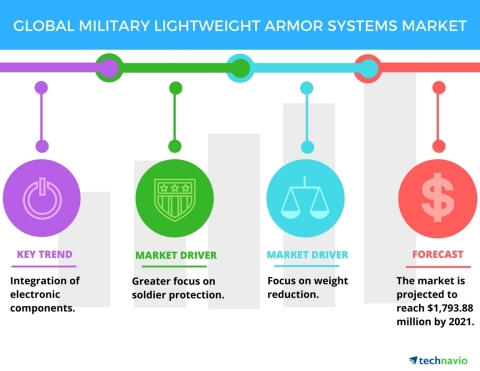LONDON--(BUSINESS WIRE)--Technavio’s latest report on the global military lightweight armor systems market provides an analysis of the most important trends expected to impact the market outlook from 2017-2021. Technavio defines an emerging trend as a factor that has the potential to significantly impact the market and contribute to its growth or decline.
The Americas has been the forerunner in the development of lightweight body armors, and it is expected that region will lead the market during the forecast period. Its considerable funding in the development of lightweight body armors is attributed to the proactive response of the US to equip its military personnel with the best possible protective systems. In this regard, the US has developed soldier modernization programs like the Warrior Web Program (WWP) of the Defense Advanced Research Projects Agency (DARPA), Improved Outer Tactical Vest (IOTV), followed by Torso and Extremities Protection (TEP). These programs focus on using advanced technology and material science to develop sophisticated yet comfortable-to-wear armors.
This report is available at a USD 1,000 discount for a limited time only: View market snapshot before purchasing
Buy 1 Technavio report and get the second for 50% off. Buy 2 Technavio reports and get the third for free.
The top three emerging trends driving the global military lightweight armor systems market according to Technavio aerospace and defense research analysts are:
- Integration of electronic components
- Development of soft and flexible body suits
- Emergence of liquid body armors
Looking for more information on this market? Request a free sample report
Technavio’s sample reports are free of charge and contain multiple sections of the report including the market size and forecast, drivers, challenges, trends, and more.
Integration of electronic components
“The incorporation of electronic components into body armors is trending in the market. With the highly dynamic war environment, soldiers must be provided with more situational awareness and connectivity for their constant interaction with command centers,” says Moutushi Saha, a lead analyst at Technavio for research on defense.
Designers are focusing on making mission-centric, scalable, and modular armors. This is supported by advancements in electronics that have made it possible to include sensors, communication, and data gathering instruments in body armors. For instance, MKU, India, offers a Custom Integrated Body Armour (CIBA). The components of CIBA include a hung display panel, headset connection, global positioning system, communication kit, and SDT pouches.
Development of soft and flexible body suits
“Ergonomic body armors are developed using soft and flexible materials, which make them light weight and convenient to wear. Researchers at Harvard University are developing soft armors by taking into consideration the bio-mechanics of human beings. The major advantage of these soft armors is that they augment the muscular abilities of the wearer and limit the chances of muscular strain,” adds Moutushi.
Superflex has launched SuperFlex, a soft material body suit. The suit was originally developed for DARPA's WWP and is now being extended for different applications. The battery-powered suit is incorporated with robotic muscles, sensing equipment, and processors and enables soldiers to expend less energy and reduces their chances of suffering injuries.
Emergence of liquid body armors
Liquid body armors are made of a liquid material with superior stab resistance and ballistic protection properties. These armors are more flexible and lighter compared with conventional Kevlar vests, thus extending enhanced mobility and performance capabilities.
Polish manufacturer, Moratex, is testing a shear thickening fluid (STF), which transforms to become hard when impacted. Although the exact composition of the STF has been kept classified, structurally it is made of hard nanoparticles suspended in a liquid.
Browse Related Reports:
- Global Submarine Market 2017-2021
- Global Military Fighting Vehicles Market 2017-2021
- Global Counter Unmanned Aerial Vehicle (UAV) Defense System Market 2017-2021
About Technavio
Technavio is a leading global technology research and advisory company. Their research and analysis focuses on emerging market trends and provides actionable insights to help businesses identify market opportunities and develop effective strategies to optimize their market positions.
With over 500 specialized analysts, Technavio’s report library consists of more than 10,000 reports and counting, covering 800 technologies, spanning across 50 countries. Their client base consists of enterprises of all sizes, including more than 100 Fortune 500 companies. This growing client base relies on Technavio’s comprehensive coverage, extensive research, and actionable market insights to identify opportunities in existing and potential markets and assess their competitive positions within changing market scenarios.
If you are interested in more information, please contact our media team at media@technavio.com.




